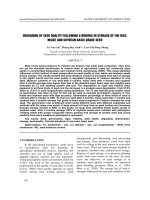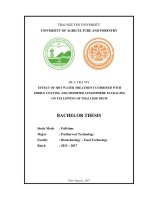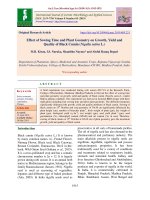Effect of polymer coating, plant biocides and insecticide on seed quality of fodder cowpea during storage
Bạn đang xem bản rút gọn của tài liệu. Xem và tải ngay bản đầy đủ của tài liệu tại đây (286.81 KB, 7 trang )
Int.J.Curr.Microbiol.App.Sci (2020) 9(3): 962-968
International Journal of Current Microbiology and Applied Sciences
ISSN: 2319-7706 Volume 9 Number 3 (2020)
Journal homepage:
Original Research Article
/>
Effect of Polymer Coating, Plant Biocides and Insecticide on
Seed Quality of Fodder Cowpea during Storage
R. Renuka*, Vinodkumar* and B. S. Vyakaranahal
Department of Seed Science and Technology, College of Agriculture, UAS,
Dharwad-580005, Karnataka, India
*Corresponding author
ABSTRACT
Keywords
Biocides,
Insecticides,
Polymer coating,
Germination, Cloth
bag, HDPE bag and
Seedling vigour
index
Article Info
Accepted:
05 February 2020
Available Online:
10 March 2020
The laboratory experiment was conducted at the Seed Quality Research
Laboratory of National Seed Project, Seed Unit. University of Agricultural
Sciences, Dharwad during 2016-2017 to evaluate effect of polymer coating, plant
biocides and insecticide on seed quality of fodder cowpea during storage. The
experiment consisted of totally 16 treatment combinations involving two factors
viz., first factor consists of two containers ( C1:Cloth bag and C2:HDPE bag) and
second factor consists of 8 seed treatments viz.,[T1 : Control, T2 : Polymer seed
coating @ 5 mlkg-1 of seed, T3 : Vitavax(Carboxin 37.5 % @ 2 gkg-1 of seeds +
Thiram @ 2 gkg-1 of seed),T4 : Aluminium phosphide @ 1 tablet/250 cuft, T5
:Methomyl @ 0.6 gkg-1 of seed, T6 : Neem oil @ 5 mlkg-1 of seed, T7: Castor oil
@ 5 mlkg-1 of seed ,T8: Sweet flag @ 5 gkg-1 of seed. Among all the treatments T3
(Vitavax (Carboxin 37.5 % @ 2 gkg-1 of seeds + Thiram @ 2gkg-1 of seed)
showed maximum seed quality parameters like germination (89.83 %), Root
length (18.76 cm), shoot length(15.60 cm),seedling vigour index (3230).Where as
the lowest germination (80.00 %), root length(14.40 cm), shoot length(11.26 cm),
seedling vigour index (2125) were recorded in control at the end of nine months
of storage period.
Introduction
Cowpea (Vigna unguiculata (L.) is one of the
most important pulse legume. It is native to
central Africa, belongs to the family
Fabaceae. Pulses are excellent sources of
proteins (20-40 %), carbohydrates (50 - 60 %)
and are fairly good sources of thiamin, niacin,
calcium and iron. Hence, they form an integral
part of our diet and also they occupy major
portion of agricultural land and are the second
most important group of crops worldwide
(Arora, 1989). Apart from its protein content,
pulses due to their nitrogen fixing ability,
enrich soil fertility. One of the major
constraints in storing the cowpea seeds from
harvest to next sowing is storage insect pests
which inflict severe losses. Pulse beetle is a
962
Int.J.Curr.Microbiol.App.Sci (2020) 9(3): 962-968
major pest that causes serious damage and is a
cosmopolitan. The pulse seed suffer a great
damage during storage due to insect attack.
Several bruchid species attack cereals and
pulses in the store and causes a loss of 1015% with a germination loss ranging from 5092.
Cowpea is no exception because of its high
protein content, cowpea seed is highly
affected by storage pests and other microflora.
The pulse beetle (Callosobruchus chinensis)
in storage causes considerable losses and
affects the quality of seed. The taking care of
seeds during storage, therefore is of supreme
importance for India‘s economic well-being
and self-sufficiency.
Information on seed treatment of fodder
cowpea with different organic and in-organic
source is quite meagre and scanty. Hence,
studies on seed storability of fodder cowpea
using different organic and inorganic sources
of seed treatment was conducted to assess the
storability of fodder cowpea seeds using cloth
bag and high density polythene bag (HDPE)
under ambient conditions of Dharwad.
Materials and Methods
The experiment was conducted in the Seed
Quality Research Laboratory of National Seed
Project, Seed unit, University of Agricultural
Sciences, Dharwad on influence of polymer
coating, plant biocides and insecticide on seed
quality of fodder cowpea during storage
during 2016 and 2017. Cowpea (Cv.MFC 9-1)
Seeds were obtained from Indian Grassland
and Fodder Research Institute, Southern
Regional Research Station, Dharwad.
The experiment consisted of two factors,
factor on is containers viz. Cloth bag(C1) and
HDPE bag (C2). The second factor deals with
seed treatments viz., T1: Control, T2: Polymer
seed coating @ 5 ml/kg of seed, T3: Vitavax
(Carboxin 37.5 %) @ 2 g/kg of seeds +
Thiram @ 2 g/kg of seed), T4: Aluminium
phosphide @ 1 tablet/250 cuft, T5: Methomyl
@ 0.6 g/kg of seed, T6: Neem oil @ 5 ml/kg of
seed, T7: Castor oil @ 5 ml/kg of seed, T8:
Sweet flag @ 5 g/kg of seed.
Observations on seed quality parameters were
recorded monthly. The mean data obtained
from the experiment was statistically analysed
and subjected to the Analysis of variance by
adopting appropriate statistical methods as
outlined by Panse and Sukhatme (1967). The
critical differences were calculated at one per
cent level of significance. The percentage data
of germination were transformed into arcsine
root transformation before analysis.
Results and Discussion
Germination (%)
The results of germination percentage as
influenced by effect of polymer coating, plant
biocides and insecticide on seed quality of
fodder cowpea during storage are presented in
(Table 1). Significant differences in
germination percentage due to seed treatments
were recorded from fifth month onwards till
the end of the storage period.
Significantly highest germination (94.0 %)
was recorded at 5th month in T3 (Carboxin
37.5 % @ 2 gkg-1 of seeds + Thiram @ 2 gkg1
of seeds) which was on par with T7 (Castor
oil @ 5 mlkg-1 of seed) of 93.3 per cent and T8
(Sweet flag @ 5 gkg-1 of seed) 92.8 per cent,
while significantly lowest germination per
cent was recorded in T1 - control (89.2 %).
The germination percentage does not differ
significantly due to containers. Higher
germination was recorded in C2 (HDPE bag)
(84.7 %) and lower germination was recorded
in C1 (cloth bag) (84.0 %) at the end of nine
months of storage period.
963
Int.J.Curr.Microbiol.App.Sci (2020) 9(3): 962-968
Table.1 Effect of polymer coating, plant biocides and insecticide on germination (%) and root length (cm) during storage period
Treatments
Containers
(C)
Treatments
(T)
Interaction
(CX T)
Germination (%)
Months after storage
Root length (cm)
Months after storage
Initial month
3rd month
5th month
7th month
9th month
Initial
month
3rd month
5th month
7th month
9th month
(C1)
95.6 (78.0)
94.3 (76.3)
91.1 (72.8)
88.3 (70.5)
84.0 (66.0)
21.00
19.47
18.42
16.81
15.44
(C2)
95.9 (78.2)
94.7 (76.8)
92.0 (73.6)
88.8 (70.6)
84.7 (67.1)
21.05
19.49
18.57
16.96
15.66
Mean
95.8 (78.2)
94.5 (76.5)
91.5 (73.2)
88.6 (70.3)
84.3 (66.8)
21.02
19.48
18.49
16.89
15.55
SEm±
0.24
0.35
0.28
0.14
0.21
0.14
0.14
0.07
0.06
0.09
CD (0.01)
NS
NS
NS
NS
NS
NS
NS
NS
NS
NS
T1
94.8 (76.9)
93.3 (75.4)
89.2 (71.0)
85.3 (67.5)
80.0 (63.5)
20.86
19.16
17.22
15.98
14.04
T2
95.7 (78.0)
94.3 (76.2)
91.0 (72.6)
86.5 (68.4)
82.2 (65.0)
21.03
19.51
18.62
16.73
15.29
T3
96.7 (79.5)
96.0 (78.6)
94.0 (75.8)
92.0 (73.6)
89.8 (71.4)
21.09
19.58
18.76
17.34
16.19
T4
95.7 (78.0)
94.0 (75.8)
89.5 (71.1)
86.0 (68.0)
81.0 (64.2)
21.02
19.50
18.61
16.65
15.24
T5
95.2 (77.3)
93.8 (75.6)
89.8 (71.4)
85.8 (67.9)
80.7 (63.9)
21.01
19.48
18.60
16.63
15.18
T6
95.8 (78.3)
94.5 (76.4)
92.5 (74.1)
90.5 (72.0)
86.3 (68.3)
21.05
19.53
18.69
17.23
16.13
T7
96.2 (78.7)
95.3 (77.5)
93.3 (75.0)
91.3 (72.9)
88.0 (69.7)
21.08
19.56
18.73
17.29
16.18
T8
96.2 (78.7)
94.8 (76.9)
92.8 (74.5)
91.0 (72.5)
86.8 (68.7)
21.07
19.54
18.71
17.25
16.15
SE m±
0.48
0.70
0.56
0.28
0.43
0.05
0.13
0.14
0.11
0.18
CD(0.01)
NS
NS
2.17
1.08
1.65
NS
NS
0.54
0.43
0.70
C1T1
94.7 (76.7)
93.3 (75.7)
89.0 (71.0)
85.3 (67.5)
80.0 (63.5)
20.83
19.13
16.70
15.45
13.22
C1T2
95.7 (78.0)
94.0 (75.8)
90.0 (71.6)
86.3 (68.3)
82.0 (65.0)
21.01
19.50
18.60
16.72
15.28
C1T3
96.33 (79.0)
95.67 (78.0)
93.67 (75.4)
91.67 (73.2)
89.67 (71.2)
21.06
19.57
18.76
17.33
16.19
964
Int.J.Curr.Microbiol.App.Sci (2020) 9(3): 962-968
C1T4
95.67 (78.0)
93.67 (75.4)
89.00 (70.6)
85.67 (67.8)
80.67 (63.9)
21.00
19.48
18.58
16.63
15.21
C1T5
95.00 (77.1)
93.67 (75.4)
89.67 (71.2)
85.67 (67.8)
80.33 (63.7)
21.00
19.47
18.57
16.62
15.16
C1T6
95.67 (78.0)
94.33 (76.2)
92.00 (73.6)
90.33 (71.9)
85.67 (67.8)
21.02
19.52
18.68
17.22
16.13
C1T7
96.00 (78.5)
95.00 (77.1)
93.00 (74.7)
91.00 (72.5)
87.67 (69.4)
21.05
19.55
18.73
17.28
16.17
C1T8
96.00 (78.5)
94.67 (76.7)
92.33 (73.9)
90.67 (72.2)
86.33 (68.3)
21.05
19.53
18.71
17.24
16.15
C2T1
95.00 (77.2)
93.33 (75.0)
89.33 (70.9)
85.33 (67.5)
80.00 (63.4)
20.89
19.20
17.74
16.51
14.86
C2T2
95.67 (78.0)
94.67 (76.7)
92.00 (73.6)
86.67 (68.6)
82.33 (65.1)
21.05
19.52
18.63
16.74
15.30
C2T3
97.00 (80.1)
96.33 (79.2)
94.33 (76.2)
92.33 (73.9)
90.00 (71.6)
21.11
19.58
18.77
17.35
16.20
C2T4
95.67 (78.0)
94.33 (76.2)
90.00 (71.6)
86.33 (68.3)
81.33 (64.4)
21.03
19.51
18.63
16.66
15.26
C2T5
95.33 (77.5)
94.00 (75.8)
90.00 (71.6)
86.00 (68.0)
81.00 (64.2)
21.01
19.49
18.62
16.64
15.20
C2T6
96.00 (78.5)
94.67 (76.7)
93.00 (74.7)
90.67 (72.2)
87.00 (68.9)
21.07
19.53
18.70
17.23
16.14
C2T7
96.33 (79.0)
95.67 (78.0)
93.67 (75.4)
91.67 (73.2)
88.33 (70.0)
21.10
19.56
18.74
17.30
16.18
C2T8
96.33 (79.0)
95.00 (77.1)
93.33 (75.0)
91.33 (72.9)
87.33 (69.1)
21.09
19.54
18.72
17.26
16.15
94.52 (76.5)
91.52 (73.2)
88.56 (70.3)
84.35 (66.8)
21.02
19.48
18.49
16.89
15.55
Mean
95.77 (78.2)
SE m±
0.67
0.99
0.79
0.39
0.60
0.06
0.18
0.20
0.16
0.26
CD (0.01)
NS
NS
NS
NS
NS
NS
NS
NS
NS
NS
965
Int.J.Curr.Microbiol.App.Sci (2020) 9(3): 962-968
Table.2 Effect of polymer coating, plant biocides and insecticide and shoot length (cm) and seedling
vigour index during storage period
Treatments
Containers
(C)
Treatments
(T)
Interaction
(CX T )
(C1)
(C2)
Mean
SE m±
CD (0.01)
T1
T2
T3
T4
T5
T6
T7
T8
SE m±
CD(0.01)
C1T1
C1T2
C1T3
C1T4
Initial
month
16.50
16.55
16.53
0.05
NS
16.33
16.48
16.83
16.45
16.43
16.50
16.69
16.51
0.09
NS
16.20
16.47
16.82
16.44
Shoot length (cm)
Months after storage
3rd
5th
7th
month
month month
16.06
15.07
14.08
16.11
15.18
14.19
16.08
15.12
14.13
0.03
0.06
0.06
NS
NS
NS
15.87
13.97
12.56
16.08
14.95
14.02
16.20
15.60
14.67
16.06
14.94
14.01
16.04
14.89
13.96
16.11
15.52
14.59
16.17
15.57
14.64
16.15
15.55
14.62
0.07
0.12
0.12
NS
0.48
0.46
15.75
13.03
12.19
16.07
14.45
14.00
16.19
15.12
14.67
16.04
14.44
13.99
Initial
month
3586
3607
3596
26
NS
3527
3588
3665
3584
3563
3598
3632
3614
52
NS
3505
3586
3649
3581
Seedling Vigour Index
Months after storage
3rd
5th
7th
month month month
3349
3072
2731
3373
3130
2768
3361
3101
2750
22
20
18
NS
NS
NS
3265
2796
2436
3358
3093
2660
3434
3230
2945
3342
3075
2636
3333
3064
2625
3367
3165
2880
3406
3202
2916
3384
3181
2900
43
40
35
NS
157
136
3245
2704
2358
3343
3073
2652
3421
3218
2933
3328
3048
2623
9th
month
12.48
12.56
12.52
0.07
NS
11.26
12.36
13.01
12.35
12.30
12.93
12.98
12.96
0.13
0.51
11.02
12.34
13.01
12.33
9th
month
2399
2451
2425
16
NS
2125
2373
2623
2345
2331
2509
2566
2528
32
125
2026
2356
2618
2323
C1T5
16.42
16.03
14.39
13.94
12.28
3555
3325
3032
2618
2314
C1T6
16.49
16.10
15.03
14.58
12.92
3588
3360
3146
2873
2489
C1T7
16.68
16.17
15.09
14.64
12.98
3622
3393
3189
2904
2555
C1T8
16.50
16.14
15.06
14.61
12.95
3605
3377
3163
2888
2513
C2T1
16.46
15.98
13.72
12.94
11.51
3549
3284
2887
2513
2223
C2T2
16.48
16.09
14.49
14.04
12.38
3590
3372
3113
2667
2390
C2T3
16.84
16.21
15.13
14.68
13.02
3682
3448
3243
2957
2629
C2T4
16.46
16.07
14.48
14.03
12.37
3587
3357
3102
2650
2367
C2T5
16.45
16.05
14.43
13.98
12.32
3571
3341
3096
2633
2348
C2T6
16.51
16.11
15.05
14.60
12.94
3608
3375
3184
2886
2530
C2T7
16.70
16.18
15.10
14.65
12.99
3642
3419
3214
2928
2577
C2T8
16.52
16.15
15.08
14.63
12.97
3624
3391
3199
2912
2543
Mean
16.53
16.08
15.12
14.13
12.52
3596
3361
3101
2750
2425
SE m±
0.13
0.09
0.18
0.17
0.19
74
61
57
50
46
CD (0.01)
NS
NS
NS
NS
NS
NS
NS
NS
NS
NS
966
Int.J.Curr.Microbiol.App.Sci (2020) 9(3): 962-968
Interaction effects due to containers and seed
treatments recorded non-significant difference
throughout the storage period however, the
seed treatment C2T3 recorded higher
germination percentage of 90.0, which was on
par with C1T3 (89.7 %) and C2T8 (88.3 %) and
the lowest germination was recorded in C1T1
(80.0 %) at the end of nine month of storage
period.
Interaction effects due to containers and seed
treatments recorded non-significant difference
throughout the storage period however the
treatment combination of C2T3 recorded
higher root length, shoot length and vigour
index of 16.20 cm 13.02 cm and 2629,
respectively and lowest root length, shoot
length and vigour index was recorded in C1T1
13.22 cm, 11.02 cm and 2026, respectively at
the end of nine month of storage period.
Vitavax power minimizes the impact of
ageing enzymes; it also acts as a protective
agent against seed deterioration due to fungal
invasion and physiological ageing as a result
of which the seed viability was maintained
comparatively for longer period of time by
acting as anti-ageing agent and there by
maintained the germination percentage
throughout the storage period. These results
are in agreement with the findings Sushma
(2003) in chickpea; Vinod Kumar et al.,
(2012) in pigeon pea.
Different seed treatments showed significant
variations in seed qualitative and quantitative
parameters throughout the nine months of
storage period. The germination percentage
(%), root length (cm), shoot length (cm) and
seedling vigour index of cowpea seeds
decreased gradually with increase in the
period of storage in all the treatment
combinations, which might be attributed to
the
phenomenon
of
physiological
deterioration, natural ageing and depletion of
food reserves and might be due to damage
caused by fungi and insects and also toxic
metabolites which might have hindered the
seedling growth, gradual decline in seed
vigour index was noticed due to age induced
decline in germination, decrease in dry matter
accumulation in seedling and decrease in
seedling length at the end of nine months of
storage. Similar findings are in conformity
with findings of Vinodkumar et al., (2010) in
cowpea and Omvati and Verma (2014) in
soybean.
Root length, shoot length and Seedling
vigour index
Significant differences due to seed treatments
on root length shoot length and vigour index
recorded. Significantly highest root length,
shoot length and vigour index was observed
18.76cm, 15.60cm and 3230, respectively was
recorded at 5th month in T3 (Carboxin 37.5 %
@ 2 gkg-1 of seeds + Thiram @ 2 gkg-1 of
seeds). While the lowest root length (14.04
cm), shoot length (11.26 cm) and vigour
index (2936) was recorded in T8 control
(Without treatment).
Based on the above discussion it is clear that
from the results obtained, is concluded that
irrespective of seed treatments seed quality
parameters decreased with the advancement
of storage period. Among all the seed
treatments, T3 (Carboxin 37.5 % @ of seeds +
Thiram @ 2 gkg-1 of seeds) gave significantly
highest germination percentage root length,
shoot length and seedling vigour index at the
end of nine month of storage period and
The root length shoot length and vigour index
do not differed significantly due to containers
during storage period. At the end of nine
months of storage period numerically higher
root length (15.66 cm), shoot length (12.56
cm) and vigour index (2451) was recorded in
C2 (HDPE bag).
967
Int.J.Curr.Microbiol.App.Sci (2020) 9(3): 962-968
which was on par withT7 (Castor oil @ 5
mlkg-1 of seed). While significantly lowest
germination percentage was recorded in T1
control (Without treatment). However, the
minimum germination of 75 % as per the
IMSCS (Indian Minimum Seed Certification
Standard) was maintained in vitavax power
even after nine months of storage period.
Singh, V. N., and Singh, Y. P., 1995, Relative
to resistance of gram varieties to
Callosobruchus chinensis on the basis
of biochemical parameters. Indian J.
Entomol., 57: 77-82.
Sushma, D. M., 2003, Effect of seed
treatment and containers on seed
storability of garden pea (Pisum sativum
L.). M. Sc. (Agri.) Thesis, Univ. Agric.
Sci., Dharwad.
Upadhayay, R. G., Sharma, S. and Drawal, N.
S., 1999, Effect of Rhizobium
inoculation and graded level of P on the
growth and yield of green gram,
Legume Res., 22: 277-279.
Vinodkumar, S. B., 2012, Effect of plant
products, chemicals and polymer coat
on
seed
storability
and
field
performance of pigeon pea [Cajanus
cajan (L.) Mill sp.] cv. bsmr-736. M.
Sc. (Agri.) Thesis, Univ. Agric. Sci.,
Dharwad.
Vinod Kumar, Sridhar, K., Karthigeyan, S.,
Kulakarni, N., 2010, Assessing the
seed viability of fodder cowpea
varieties during storage using plant
biocides, fungicides and insecticides.
Range management and agroforestry,
1 (1): 41-43.
References
Abdul-Baki, A. A. and Anderson, J. D., 1973,
Vigour determination in soybean by
multiple criteria. Crop Sci., 13: 630637.
Anonymous, 2011, International Rules for
Seed Testing. Seed Sci. and Tech., 21:
1-255.
Arora, P. P., 1989, Genetic divergence studies
and scope for improvement in chickpea
National Symposium on Few Front line
in Pulse Research.
Omvati Verma and Verma R. S., 2014, Effect
of seed coating material and storage
containers on germination and seedling
vigour of soybean (Glycine max l.).
Saarc J. Agri., 12 (2): 16-24.
Panse, V. G. and Sukhatme, P. V., 1967,
Statistical Methods for Agricultural
Workers, ICAR, New Delhi, 167-174.
How to cite this article:
Renuka. R, Vinodkumar and Vyakaranahal. B. S. 2020. Effect of Polymer Coating, Plant
Biocides and Insecticide on Seed Quality of Fodder Cowpea during Storage.
Int.J.Curr.Microbiol.App.Sci. 9(03): 962-968. doi: />
968



![gold et al - 2012 -the effect of engagement and review partner tenure and rotation on audit quality - evidence from germany [mapr]](https://media.store123doc.com/images/document/2015_01/06/medium_YF2viUqvRF.jpg)





